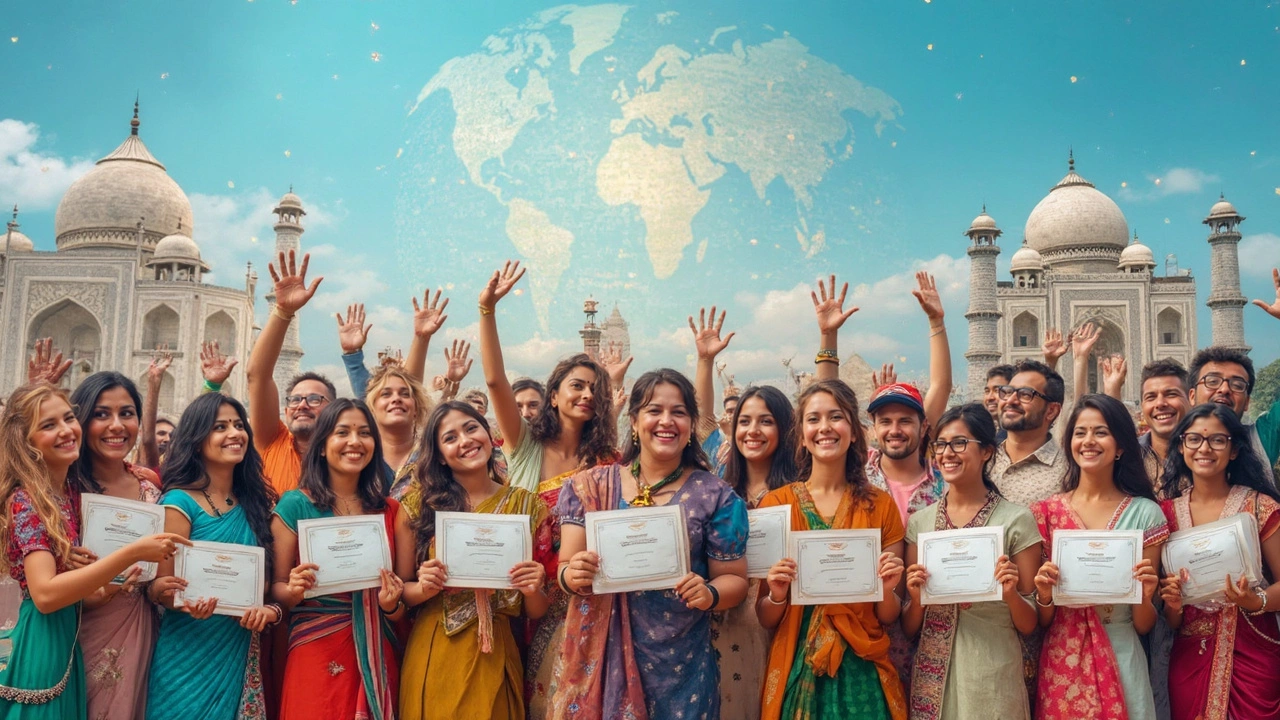High School Diploma Equivalent in India: What You Need to Know

Ever wondered what the high school diploma equivalent is in India? If you're looking to connect Indian education with international standards, this topic is super relevant. In India, the terms that pop up are the Higher Secondary Certificate (HSC) and the Senior Secondary Certificate (SSC). But what do these mean?
Basically, after slogging through about 12 years of schooling, students in India get one of these certs. The HSC or SSC is usually what students flash when they, say, want to grab a college spot overseas or explain their schooling to an employer unfamiliar with sweet samosas and the Indian education system.
Stick around, because we’re breaking down how these certificates stack up in the global arena, and we’ve got a few tips to make sure your Indian badges get their due credit on the world stage.
- Understanding the Indian Education System
- What is the Higher Secondary Certificate?
- Senior Secondary Certificate: A Closer Look
- How Global Institutions View Indian Certificates
- Tips for Using Indian Certificates Internationally
Understanding the Indian Education System
Diving into the Indian education system can feel like unraveling a giant tapestry. It's intricate and rich with history. First off, schooling in India is structured into a few main stages: primary, secondary, and then higher secondary. Kids usually start school at age six, and the journey goes on for about 12 years.
Now, when we talk about the equivalent of a high school diploma in the Indian context, we generally mean the last two years of schooling, commonly called the 'higher' or 'senior' secondary school level. These years are crucial because they finish up with important exams that determine eligibility for higher education and jobs.
One interesting fact? Schools follow different curricula across regions. We've got state boards, the Central Board of Secondary Education (CBSE), and the Council for the Indian School Certificate Examinations (CISCE). Each offers its unique twists and turns, but all end with that coveted certificate.
"Indian education is known for its rigorous academic standards and a deep focus on math and science," says Professor Ravi Singh, a well-respected educator.
The Role of Examinations
Exams are a big deal here, no doubt about it. They happen at the end of each stage, but it's the exams at the end of the higher secondary level—the Higher Secondary Certificate (HSC), and the Senior Secondary Certificate (SSC)—that get all the attention. These exams can open doors, not just within India, but internationally too.
Diverse Boards and Their Impact
While the CBSE and CISCE are known across the country, the state boards are more localized, catering to their respective regions. This diversity sometimes leads to different levels of difficulty and focus. A CBSE certificate might give you an edge when applying abroad due to its widespread recognition, but local state board certificates also hold their ground strongly in regional contexts.
In essence, understanding the dynamics of the Indian education system can be key, especially if you're trying to align it with a high school diploma in any other part of the world.
What is the Higher Secondary Certificate?
So, you're curious about the Higher Secondary Certificate (HSC)? Let's break it down. In India, the HSC is a key milestone in a student's education journey. Generally, students take this exam after completing their 12th grade. It’s kind of like wrapping up the final chapter of school before heading into university life or the working world.
Typically, the HSC is administered by different state boards. Each state has its own board, like Maharashtra, Tamil Nadu, or Gujarat, and they’re the ones who call the shots regarding syllabus and exams. But what unites them is the aim to prep students for higher education or professional paths.
What's in the HSC?
Students usually choose a stream—science, arts, or commerce—based on their career goals. The thing is, these streams dictate the subjects that students focus on, so it’s a pretty important decision! For instance, science might include physics and chemistry, while commerce leans more towards subjects like economics and accountancy.
Exams don’t just drop out of the sky. The pattern is pretty regular—year-end exams, sometimes supplemented by practicals, especially if you're the science-y type. Internal assessments can also be part of the deal, depending on the board and school.
Why Does It Matter?
The significance of the Higher Secondary Certificate is huge. For one, it's your ticket to undergrad programs, both in India and abroad, depending on the university's admission criteria. Many employers, especially those with international links, tend to equate it with the standard high school diploma recognized globally.
In 2023, India saw about 9 million students sitting for their HSC exams, showing just how widespread this exam is. Talk about numbers, right? It's this commonplace nature that also gives it a certain authority.
So, if you're eyeing further studies or an international career, get ready to make the most of your HSC—a stepping stone in the right direction!

Senior Secondary Certificate: A Closer Look
The Senior Secondary Certificate (SSC) is crucial for students in India aiming to unlock future opportunities, both domestically and internationally. After completing two years of higher secondary education, students sit for exams that could either propel them into university or various vocational paths.
The SSC is typically obtained through boards like CBSE (Central Board of Secondary Education), ICSE (Indian Certificate of Secondary Education), or various state boards. Each board has its specific set of subjects, yet core areas usually include Science, Mathematics, Humanities, and Commerce. These courses prepare students for higher education and vocational training, offering a broader choice than the junior levels.
Focus Areas and Opportunities
Want to dive deep into engineering or medicine? Your score in the SSC matters a lot! The marks obtained often determine eligibility for entrance exams like JEE or NEET, which are gateways to some of the best colleges in India.
Plus, the SSC is not just about academics. Schools encourage participation in extracurriculars, which helps in applying for colleges or even scholarships abroad. From debates to sports, what you achieve here shapes your profile significantly.
Global Recognition and Challenges
Outside India, institutions may initially puzzle over the SSC, wondering how it compares to a high school diploma. However, many countries and universities are familiar with the Indian system, acknowledging its rigor. Still, make sure to prepare proper documentation and proof of equivalence whenever applying internationally.
While there is no one-size-fits-all international equivalent, the SSC often aligns with the completion of Grade 12 in regions like North America. Still, verifying requirements with the target institution or company is wise.
| Board | Key Subjects | Purpose |
|---|---|---|
| CBSE | Science, Commerce, Arts | Higher Education, Vocational Options |
| ICSE | English, Math, Science | Skill Development, International Applications |
So if you're holding an Indian SSC, be confident about your qualifications but prepared to articulate its value. Whether you’re applying for a degree overseas or a job in a new country, understanding how the SSC fits into global educational standards can enhance both your prospects and confidence.
How Global Institutions View Indian Certificates
Wondering how your high school diploma stacks up internationally? You're not alone. Students often find themselves pondering this while navigating applications to global universities or employment overseas. But fear not! Indian certificates like the Higher Secondary Certificate (HSC) and Senior Secondary Certificate (SSC) hold significant value.
In many countries, these certificates are recognized as equivalent to a high school diploma. The HSC and SSC are usually considered the completion of secondary education, just like a traditional high school diploma. That being said, the acceptance can sometimes vary depending on specific universities or countries.
Recognition in Popular Study Destinations
Let's take the United States, for example. Many U.S. colleges and universities appreciate the structure and rigor of the Indian education system. Similarly, in Canada, Indian HSC holders find their credentials widely accepted, often seen as equivalent to the Canadian Grade 12. In the UK, these certificates typically match up to the Level 3 of the National Qualifications Framework. Cool, right?
Variations in Acceptance
While Indian certificates do get a thumbs-up from a lot of institutions, it's essential to check specific program requirements. Some programs may require additional assessments or proof of English proficiency. Countries like Australia and Germany, for example, may have specific prerequisites or language benchmarks. No harm in double-checking!
Quick Tips for a Smoother Process
- Research specific institutions that pique your interest to know their requirements.
- Don't hesitate to reach out to admission offices for clarification—most of them are happy to help.
- Consider taking standardized tests like the SAT or ACT if the school suggests them—it can boost your application.
Understanding how Indian certificates are viewed abroad can open up a world of opportunities. It's all about knowing your cert's worth and playing your cards right!

Tips for Using Indian Certificates Internationally
Taking your Indian education credentials across borders can seem daunting at first. But fret not, there are ways to make it a smooth ride. Here’s how you can make the world take notice of your Higher Secondary Certificate (HSC) or Senior Secondary Certificate (SSC).
Understand International Recognition
First off, know where your certificate stands. The HSC and SSC are generally equivalent to a high school diploma in many countries. This can open doors to undergraduate programs abroad. However, every institution has its own criteria. Universities in countries like the USA and the UK often evaluate these Indian certificates through agencies like the World Education Services (WES). It’s always a smart move to check with your target institution about their specific requirements.
Translation and Notarization
If you're presenting your certificates in a non-English-speaking country, get them translated. Make sure these translations are certified. Notarization can also add an extra layer of authenticity. This can help avoid any hitches during the application process.
Highlighting Key Subjects
Got top scores in specific subjects? Mention them prominently in your applications. Highlight those marks in your diploma equivalent that match the preferred coursework of foreign universities. It’s all about showing your strengths.
Seek Professional Evaluation
For employers and educational institutions abroad, having a third-party evaluation of your credentials can be valuable. Services like WES offer comprehensive assessments that translate your Indian certificates into U.S. equivalencies, demystifying the Indian education system for overseas evaluators.
- Reach out to WES or similar agencies to understand their process and documentation requirements.
- Make sure to submit all necessary documents, including mark sheets from your Higher Secondary and Senior Secondary Certificates.
- Use their evaluations as part of your college applications or resume submissions.
Networking and Support
Join online communities or forums of students who transitioned from Indian schooling to international studies. This is a great way to get firsthand accounts of navigating these waters. Many students share tips on overcoming common challenges, making the transition smoother than you'd expect.
Stats for Consideration
Did you know almost 200,000 Indian students choose to study abroad every year? Here’s how this demographic is spread across some popular destinations:
| Country | Percentage of Indian Students |
|---|---|
| USA | 32% |
| Canada | 21% |
| Australia | 15% |
These numbers show a trend, indicating that getting your Indian certificates accepted isn’t just possible; it’s already a well-trodden path. Just follow these tips and prep yourself for a rewarding journey.

Post-Comment